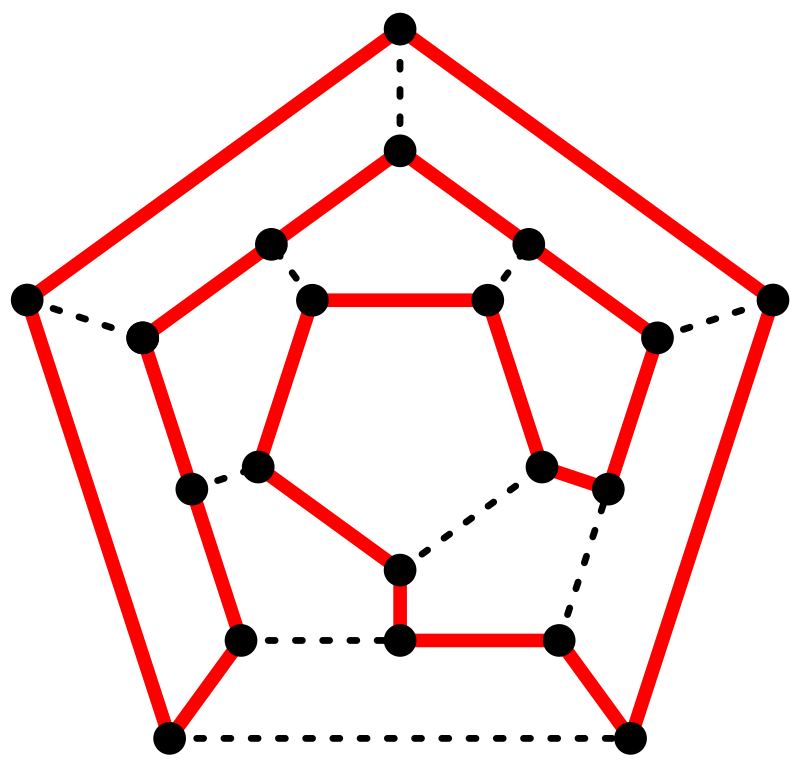[Quantum Information] Grover Search Algorithm
Grover Search Algorithm
Notes from RWTH Aachen University course
“Quantum Information” Summer semester 2020
professor: Müller, Markus
Grover Search Algorithm
Complexity
Complexity class P
- example: Eulerian path
- Finding the solution: polynomially with the size of the problem
- checking the solution is easy as well
Complexity class NP
- example: Hamiltonian path
- finding the solution is hard (cannot be achieved in polynomial time)
- checking the solution is easy
- NP: solution can be found by non-deterministic (N) Turing machine in polynomial time
such machine does not exist
Hamiltonian Cycle (HC) can be reduced to Traveling Salesman Problem (TSP)
- If we can solve TSP, then we can solve HC
(\(G\) of HC, the original edges weight \(1\) and the non-existing edges weight \(2\), if there is a cycle value < \((n+1)\), where \(n=(\#\text{ nodes})\), it contains HC.) - If TSP is tractable, then HC is also tractable
- If HC is hard, then TSP must also be hard
- If we can solve TSP, then we can solve HC
example: \(k\)-coloring
- Graph \(2\)-coloring is P
- Graph \(3\)-coloring is in NP-complete
- sudoku: NP-complete
- \(2\)-SAT (satisfiability) is P
- \((x_1\lor \bar{x_3})\land(x_2\lor \bar{x_4})\land...\)
- \(3\)-SAT (satisfiability) is NP-complete
- \((x_1\lor \bar{x_2}\lor \bar{x_4})\land(x_2\lor \bar{x_3}\lor \bar{x_5})\land...\)
BQP: bounded-error quantum polynomial time
- with error probability of at most \(\varepsilon\)
many decision problem can be considered as search problem
Grover Search Algorithm
- Problem:
- Search through the space of \(N=2^n\) elements
- \(n\) bits information of the element
- assume that the number of solutions is exatly \(M, M\ll N\)
- can be represented by a function \(f\)
- \(f(x) = 1\), then \(x\) is the answer
- \(f(x) = 0\), then \(x\) is not the answer
- Algorithm:
- Oracle: \(O_f\)
- \(|x\rangle|-\rangle\xrightarrow[]{O_f}(-1)^{f(x)}|x\rangle|-\rangle\)
- If measure \(|x\rangle\), then \(x\) is not a solution
If measure \(-|x\rangle\), then \(x\) is a solution
the oracle does not know any of the solution, it only able to recognize a solution
- Oracle: \(O_f\)
- Prepare the initial state
- \[|\psi\rangle=\frac{1}{\sqrt{N}}\sum_x |x\rangle\]
- \(\begin{aligned} \frac{1}{\sqrt{N}}\sum_x |x\rangle &= \frac{1}{\sqrt{N}}(\sqrt{N-M}\frac{1}{\sqrt{N-M}}\sum_{f(x)\neq 1} |x\rangle+\sqrt{M}\frac{1}{\sqrt{M}}\sum_{f(x)= 1} |x\rangle)\\ &= \sqrt{\frac{N-M}{N}}|\alpha\rangle+\sqrt{\frac{M}{N}}|\beta\rangle \\ &= \sqrt{1-\varepsilon}|\alpha\rangle+\sqrt{\varepsilon}|\beta\rangle \end{aligned}\)
where \(\varepsilon=M/N\ll1\) - probability to find any solution. projector onto the solution space:
\[\hat{P}=\sum_{f(x)=1}|x\rangle\langle x|\]
probability = \(\langle\psi|\hat{P}|\psi\rangle=\varepsilon\)
- Prepare a grover step \(G\) iteratively \(k\) times
- applying oracle \(O_{f,\pm}\)
- The oracle
\[O=\mathbb{1}-2\hat{P}=\mathbb{1}-2\sum_{f(x)=1}|x\rangle\langle x|\]
then
\(O|x\rangle=|x\rangle\), if \(|x\rangle\) is not a solution
\(O|x\rangle=-|x\rangle\), if \(|x\rangle\) is a solution
- The oracle
- applying reflection operator \(U=2|\psi\rangle\langle\psi|-\mathbb{1}\)
- $\begin{aligned}UO|\psi\rangle &= (2|\psi\rangle\langle\psi|-\mathbb{1})(|\psi\rangle - 2\sqrt{\varepsilon}|\beta\rangle)\\ &= (1-4\varepsilon)\sqrt{1-\varepsilon}|\alpha\rangle+(3-4\varepsilon)\sqrt{\varepsilon}|\beta\rangle \end{aligned}
$ - now, the probability to find any solution is \(\approx 9\cdot\varepsilon\)
increase by a factor of \(9\) - geometric visualization
- \(O_f\): reflect \(|\psi\rangle\) over \(|\beta\rangle\)
- \(G\): reflect \(O|\psi\rangle\) over \(|\psi\rangle\)
- the original angle \(\theta/2\)
after \(GO_f\), rotated by \(\theta\) to \(|\beta\rangle\)
- after \(k\) iterations
\[ G^k|\psi\rangle=\cos{(\frac{2k+1}{2}\theta)}|\alpha\rangle+\sin{(\frac{2k+1}{2}\theta)}|\beta\rangle\] - the optimal \(k\) steps
\[k\approx \frac{\pi}{4}\sqrt{\frac{N}{M}}\] - complexity:
\[O(\sqrt{\frac{N}{M}})\]
classical: \(O(N/M)\), a quadratic speedup
- $\begin{aligned}UO|\psi\rangle &= (2|\psi\rangle\langle\psi|-\mathbb{1})(|\psi\rangle - 2\sqrt{\varepsilon}|\beta\rangle)\\ &= (1-4\varepsilon)\sqrt{1-\varepsilon}|\alpha\rangle+(3-4\varepsilon)\sqrt{\varepsilon}|\beta\rangle \end{aligned}
- applying oracle \(O_{f,\pm}\)
- measuring all \(n\)-qubits yields an outcome \(x\)
- Discussion
- Is not reaching the solution state \(|\beta\rangle\) exatly?
- in generally \(\tilde{k}\) is not an integer
- choose the nearest \(k\) still with small error probability
- Quantum computer cannot solve the NP-complete problem efficiently.
- example: Hamiltonian Path
- complexity \(O(n^n)=O(2^{n\cdot\log(n)})\)
- quantum computing \(O(p(n)2^{n\cdot\log(n)/2})\)
- \(p(n)\): polynomial overhead
- \(/2\): quantum speedup
- Grover Search is optimal
- can be proved no quantum algorithm can use less than \(O(\sqrt{\frac{N}{M}})\) oracle access
Reading
Nielsen and Chuang
6.1 The quantum search algorithm





留言
張貼留言